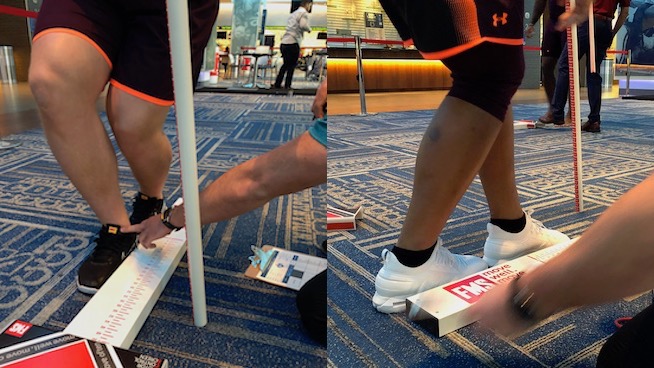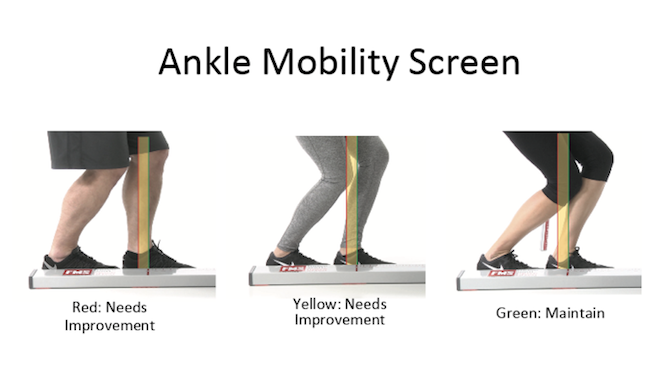This Ankle Mobility Test Is Used at the NFL Combine. Can You Pass It?
We take our feet for granted.
Often out of sight and out of mind, we simply assume they’re functioning as intended, instead dedicating greater attention to big, powerful muscle groups and those that define an attractive physique.
But as we continue to learn more about the function of the foot and ankle in athletic performance, it’s clear that to neglect its role in movement would be a dire mistake. Poor foot and/or ankle function makes us slower, less powerful and more fragile.
“Most people don’t think about their foot or their ankle until there’s a problem,” says Lee Burton, co-founder of Functional Movement Systems (FMS).
Research has found limited ankle mobility results in inactivity of the glutes as well as an increased risk of lower-body injury. Such findings are why an ankle mobility test has become part of the battery NFL prospects undergo at the FMS station at the NFL Combine.
“If you don’t have good ankle mobility, when you start a closed chain activity your glutes will shut down. You won’t have good glute activation if you don’t have a full or good range of motion in your ankle—good dorsiflexion (flexing of the foot so the toes come towards the shin), specifically. The other thing is that with limited ankle mobility, there’s quite a bit of research that says your injury risk will be elevated,” Burton says.
Although modern athletes are posting mind-boggling speed, strength and power numbers, their ankle and foot function is often worse than the generations who came before them.
There are a number of potential causes for this. Spending too much of their childhood in restrictive footwear can lead to several issues, including flat feet, a postural deformity characterized by underdeveloped arches. As an example of issues “running up the chain,” flat feet can significantly impact ankle mobility, and not for the better. Another issue is that many modern athletes grow up taping/bracing their ankles before every practice or competition, cementing poor ankle mobility in their movement patterns.
“Most people talk about, ‘We’ve got to get core strength or hip stability.’ But they forget that if you don’t have good signals coming from your foot or you have limited ankle mobility, which a lot of people do, then you’re not going to get that input up the kinetic chain to be able to create good core stability or hip stability,” says Burton.
Burton and FMS long knew they needed to add a dedicated ankle mobility test to their screenings, but settling on the right one was crucial. Starting in 2011, they began experimenting with different ankle mobility tests. Their guinea pigs included the 300-plus athletes invited annually to the NFL Combine.
It was a process. One screen saw athletes too frequently cave their knee inward instead of tracking it over their third or fourth toe, while another proved far too difficult for an athlete to receiving a “passing” score.
After three years of trial and error, FMS settled on what they call their Closed-Chain Ankle Mobility screen. Here’s how it works:
- The athlete, with shoes on, starts in a standing position with one foot placed placed directly behind the other.
- Hold onto a dowel or rod with one end planted on the ground for balance.
- Bend your back knee forward as far as possible without your back heel rising off the floor.
- Once you are at the limit of how far you can bend your knee without the heel coming up, the test administrator should determine where your back knee is in relation to your front ankle.
- Once the result is recorded, switch feet and test the other ankle.
- The test is scored on a scale of Red, Yellow or Green. Red indicates the athlete’s ankle mobility needs significant improvement while Green indicates they possess a good level of ankle mobility that should be maintained.
Here’s what it looks like in action, courtesy of some NFL prospects, along with a chart that illustrates scores of Red, Yellow and Green:


What’s the justification behind this scoring?
Research has found that 40-plus degrees of closed-chain ankle dorsiflexion indicates optimal range of motion, while 35-40 degrees indicates adequate range of motion. For example, a study of army recruits found that a dorsiflexion range of motion under 34 degrees was associated with a five times greater risk of ankle sprain compared to individuals with normal ankle flexibility.
Anything under 35 degrees of closed-chain ankle dorsiflexion should be a concern for the athlete, and them improving that figure should become an active priority.
But FMS is used in large team settings, and taking exact degree measurements for each athlete can be a long, arduous task. Based on thousands of test results, FMS found that if you’re able to get your back knee 3-4 inches in front of your back-foot toes in the above position, that’s a simple indication your ankle mobility is sufficient. Thus, you’re scored a “Green.”
If you’re incapable of even getting the back knee to the front ankle, that indicates a score of “Red.”
“If you can’t even get that back knee in front of that front ankle in that position, you need to be focused on ankle mobility,” says Burton. “And how you do that is really up to you—there’s a lot of different things (that can help).”
Grab a buddy and try the test yourself. Videoing the test from a side view can be a good way to get a rough idea of where you stand. Remember that it’s the back ankle which is being screened, so you’ll need to switch your feet to test the opposite side.
If your ankle mobility isn’t where you’d like, read this.
Photo Credit: Functional Movement Systems, Joe Robbins/Getty Images
READ MORE:
RECOMMENDED FOR YOU
MOST POPULAR
This Ankle Mobility Test Is Used at the NFL Combine. Can You Pass It?
We take our feet for granted.
Often out of sight and out of mind, we simply assume they’re functioning as intended, instead dedicating greater attention to big, powerful muscle groups and those that define an attractive physique.
But as we continue to learn more about the function of the foot and ankle in athletic performance, it’s clear that to neglect its role in movement would be a dire mistake. Poor foot and/or ankle function makes us slower, less powerful and more fragile.
“Most people don’t think about their foot or their ankle until there’s a problem,” says Lee Burton, co-founder of Functional Movement Systems (FMS).
Research has found limited ankle mobility results in inactivity of the glutes as well as an increased risk of lower-body injury. Such findings are why an ankle mobility test has become part of the battery NFL prospects undergo at the FMS station at the NFL Combine.
“If you don’t have good ankle mobility, when you start a closed chain activity your glutes will shut down. You won’t have good glute activation if you don’t have a full or good range of motion in your ankle—good dorsiflexion (flexing of the foot so the toes come towards the shin), specifically. The other thing is that with limited ankle mobility, there’s quite a bit of research that says your injury risk will be elevated,” Burton says.
Although modern athletes are posting mind-boggling speed, strength and power numbers, their ankle and foot function is often worse than the generations who came before them.
There are a number of potential causes for this. Spending too much of their childhood in restrictive footwear can lead to several issues, including flat feet, a postural deformity characterized by underdeveloped arches. As an example of issues “running up the chain,” flat feet can significantly impact ankle mobility, and not for the better. Another issue is that many modern athletes grow up taping/bracing their ankles before every practice or competition, cementing poor ankle mobility in their movement patterns.
“Most people talk about, ‘We’ve got to get core strength or hip stability.’ But they forget that if you don’t have good signals coming from your foot or you have limited ankle mobility, which a lot of people do, then you’re not going to get that input up the kinetic chain to be able to create good core stability or hip stability,” says Burton.
Burton and FMS long knew they needed to add a dedicated ankle mobility test to their screenings, but settling on the right one was crucial. Starting in 2011, they began experimenting with different ankle mobility tests. Their guinea pigs included the 300-plus athletes invited annually to the NFL Combine.
It was a process. One screen saw athletes too frequently cave their knee inward instead of tracking it over their third or fourth toe, while another proved far too difficult for an athlete to receiving a “passing” score.
After three years of trial and error, FMS settled on what they call their Closed-Chain Ankle Mobility screen. Here’s how it works:
- The athlete, with shoes on, starts in a standing position with one foot placed placed directly behind the other.
- Hold onto a dowel or rod with one end planted on the ground for balance.
- Bend your back knee forward as far as possible without your back heel rising off the floor.
- Once you are at the limit of how far you can bend your knee without the heel coming up, the test administrator should determine where your back knee is in relation to your front ankle.
- Once the result is recorded, switch feet and test the other ankle.
- The test is scored on a scale of Red, Yellow or Green. Red indicates the athlete’s ankle mobility needs significant improvement while Green indicates they possess a good level of ankle mobility that should be maintained.
Here’s what it looks like in action, courtesy of some NFL prospects, along with a chart that illustrates scores of Red, Yellow and Green:


What’s the justification behind this scoring?
Research has found that 40-plus degrees of closed-chain ankle dorsiflexion indicates optimal range of motion, while 35-40 degrees indicates adequate range of motion. For example, a study of army recruits found that a dorsiflexion range of motion under 34 degrees was associated with a five times greater risk of ankle sprain compared to individuals with normal ankle flexibility.
Anything under 35 degrees of closed-chain ankle dorsiflexion should be a concern for the athlete, and them improving that figure should become an active priority.
But FMS is used in large team settings, and taking exact degree measurements for each athlete can be a long, arduous task. Based on thousands of test results, FMS found that if you’re able to get your back knee 3-4 inches in front of your back-foot toes in the above position, that’s a simple indication your ankle mobility is sufficient. Thus, you’re scored a “Green.”
If you’re incapable of even getting the back knee to the front ankle, that indicates a score of “Red.”
“If you can’t even get that back knee in front of that front ankle in that position, you need to be focused on ankle mobility,” says Burton. “And how you do that is really up to you—there’s a lot of different things (that can help).”
Grab a buddy and try the test yourself. Videoing the test from a side view can be a good way to get a rough idea of where you stand. Remember that it’s the back ankle which is being screened, so you’ll need to switch your feet to test the opposite side.
If your ankle mobility isn’t where you’d like, read this.
Photo Credit: Functional Movement Systems, Joe Robbins/Getty Images
READ MORE:












